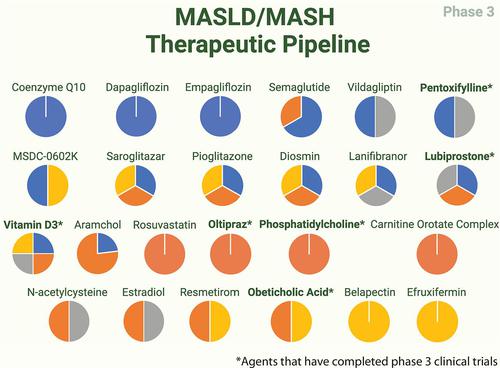当前位置:
X-MOL 学术
›
Pharmacol. Rev.
›
论文详情
Our official English website, www.x-mol.net, welcomes your feedback! (Note: you will need to create a separate account there.)
Steatotic Liver Disease: Pathophysiology and Emerging Pharmacotherapies
Pharmacological Reviews ( IF 21.1 ) Pub Date : 2024-05-01 , DOI: 10.1124/pharmrev.123.001087 Michail Kokkorakis , Emir Muzurović , Špela Volčanšek , Marlene Chakhtoura , Michael A. Hill , Dimitri P. Mikhailidis , Christos S. Mantzoros
Pharmacological Reviews ( IF 21.1 ) Pub Date : 2024-05-01 , DOI: 10.1124/pharmrev.123.001087 Michail Kokkorakis , Emir Muzurović , Špela Volčanšek , Marlene Chakhtoura , Michael A. Hill , Dimitri P. Mikhailidis , Christos S. Mantzoros

|
Steatotic liver disease (SLD) displays a dynamic and complex disease phenotype. Consequently, the metabolic dysfunction-associated steatotic liver disease (MASLD)/metabolic dysfunction-associated steatohepatitis (MASH) therapeutic pipeline is expanding rapidly and in multiple directions. In parallel, noninvasive tools for diagnosing and monitoring responses to therapeutic interventions are being studied, and clinically feasible findings are being explored as primary outcomes in interventional trials. The realization that distinct subgroups exist under the umbrella of SLD should guide more precise and personalized treatment recommendations and facilitate advancements in pharmacotherapeutics. This review summarizes recent updates of pathophysiology-based nomenclature and outlines both effective pharmacotherapeutics and those in the pipeline for MASLD/MASH, detailing their mode of action and the current status of phase 2 and 3 clinical trials. Of the extensive arsenal of pharmacotherapeutics in the MASLD/MASH pipeline, several have been rejected, whereas other, mainly monotherapy options, have shown only marginal benefits and are now being tested as part of combination therapies, yet others are still in development as monotherapies. Although the Food and Drug Administration (FDA) has recently approved resmetirom, additional therapeutic approaches in development will ideally target MASH and fibrosis while improving cardiometabolic risk factors. Due to the urgent need for the development of novel therapeutic strategies and the potential availability of safety and tolerability data, repurposing existing and approved drugs is an appealing option. Finally, it is essential to highlight that SLD and, by extension, MASLD should be recognized and approached as a systemic disease affecting multiple organs, with the vigorous implementation of interdisciplinary and coordinated action plans.
中文翻译:

脂肪肝病:病理生理学和新兴药物疗法
脂肪肝病 (SLD) 显示出动态且复杂的疾病表型。因此,代谢功能障碍相关的脂肪性肝病(MASLD)/代谢功能障碍相关的脂肪性肝炎(MASH)治疗管道正在多个方向快速扩展。与此同时,正在研究用于诊断和监测治疗干预反应的非侵入性工具,并探索临床上可行的结果作为干预试验的主要结果。认识到 SLD 下存在不同的亚组,应该可以指导更精确和个性化的治疗建议,并促进药物治疗的进步。本综述总结了基于病理生理学的命名法的最新更新,并概述了有效的药物治疗方法和正在研发的 MASLD/MASH 药物治疗方法,详细介绍了它们的作用模式以及 2 期和 3 期临床试验的现状。在 MASLD/MASH 管道中的大量药物治疗中,有几种已被拒绝,而其他主要是单一疗法的选择仅显示出边际效益,目前正在作为联合疗法的一部分进行测试,而其他疗法仍在作为单一疗法进行开发。尽管美国食品和药物管理局 (FDA) 最近批准了瑞美罗,但正在开发的其他治疗方法将理想地针对 MASH 和纤维化,同时改善心脏代谢危险因素。由于迫切需要开发新的治疗策略以及安全性和耐受性数据的潜在可用性,重新利用现有和已批准的药物是一个有吸引力的选择。最后,必须强调的是,SLD 以及由此延伸的 MASLD 应被视为一种影响多个器官的系统性疾病,并予以对待,并大力实施跨学科和协调的行动计划。
更新日期:2024-05-03
中文翻译:

脂肪肝病:病理生理学和新兴药物疗法
脂肪肝病 (SLD) 显示出动态且复杂的疾病表型。因此,代谢功能障碍相关的脂肪性肝病(MASLD)/代谢功能障碍相关的脂肪性肝炎(MASH)治疗管道正在多个方向快速扩展。与此同时,正在研究用于诊断和监测治疗干预反应的非侵入性工具,并探索临床上可行的结果作为干预试验的主要结果。认识到 SLD 下存在不同的亚组,应该可以指导更精确和个性化的治疗建议,并促进药物治疗的进步。本综述总结了基于病理生理学的命名法的最新更新,并概述了有效的药物治疗方法和正在研发的 MASLD/MASH 药物治疗方法,详细介绍了它们的作用模式以及 2 期和 3 期临床试验的现状。在 MASLD/MASH 管道中的大量药物治疗中,有几种已被拒绝,而其他主要是单一疗法的选择仅显示出边际效益,目前正在作为联合疗法的一部分进行测试,而其他疗法仍在作为单一疗法进行开发。尽管美国食品和药物管理局 (FDA) 最近批准了瑞美罗,但正在开发的其他治疗方法将理想地针对 MASH 和纤维化,同时改善心脏代谢危险因素。由于迫切需要开发新的治疗策略以及安全性和耐受性数据的潜在可用性,重新利用现有和已批准的药物是一个有吸引力的选择。最后,必须强调的是,SLD 以及由此延伸的 MASLD 应被视为一种影响多个器官的系统性疾病,并予以对待,并大力实施跨学科和协调的行动计划。
































 京公网安备 11010802027423号
京公网安备 11010802027423号